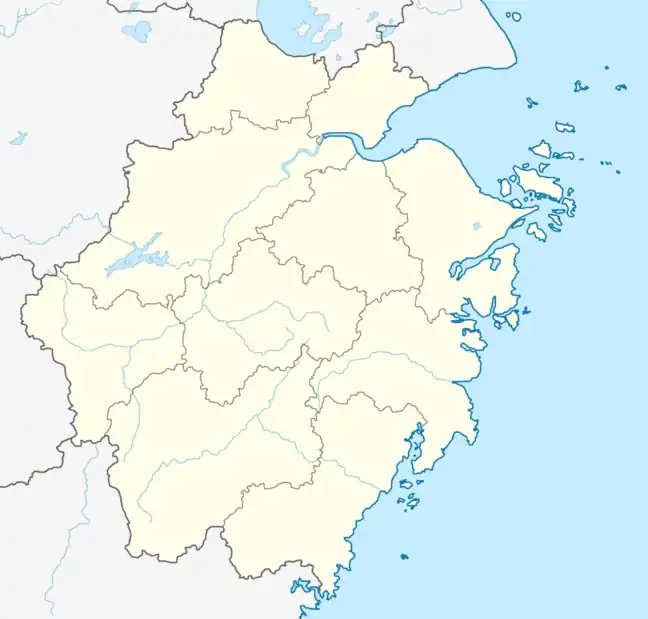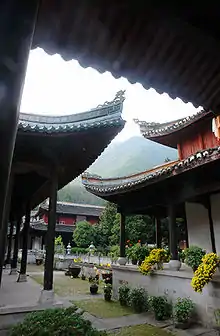Tiantai Mountain
Tiantai Mountain (also Tí Taî in the local language) is a mountain in Tiantai County, Taizhou, Zhejiang Province, China.[1] Its highest peak, Huading, reaches a height of 1,138 meters (3,734 ft).[1] The mountain was made a national park on 1 August 1988. One of nine remaining wild populations of Seven-Son Flower (Heptacodium miconioides) is located on mount Tiantai.[2]
| Tiantai Mountain | |
|---|---|
 A view of Tiantai Mountain and the pagoda of Guoqing Temple, constructed during the Sui dynasty (6th century CE). | |
| Highest point | |
| Elevation | 1,138 m (3,734 ft) |
| Coordinates | 29.178843°N 121.042213°E |
| Geography | |
 Tiantai Mountain | |
| Tiantai Shan | |||||||||||||||||||||
|---|---|---|---|---|---|---|---|---|---|---|---|---|---|---|---|---|---|---|---|---|---|
| Chinese | 天台山 | ||||||||||||||||||||
| Hanyu Pinyin | PRC Standard Mandarin: Tiāntāi Shān ROC Standard Mandarin: Tiāntái Shān | ||||||||||||||||||||
| |||||||||||||||||||||

Legends
In the mythology of Traditional Chinese religion, the creator goddess Nüwa cut the legs off a giant sea turtle (Chinese: 鳌; pinyin: áo) and used them to prop up the sky after Gong Gong damaged Mount Buzhou, which had previously supported the heavens.[3] A local myth holds that Tiantai was on the turtle's back before and Nüwa relocated it to its current position when she had to remove the turtle's legs.
Guoqing Temple
Guoqing Temple on the mountain is the headquarters of Tiantai Buddhism,[4] and also a tourist destination. Tiantai, named for the mountain, is an East Asian Buddhist school of Mahāyāna Buddhism that developed in 6th-century China and focuses on the Lotus Sutra.[4] The most prominent teacher of that school, Zhiyi, was based at Guoqing Temple.[4] Over many years it has been an important destination for pilgrims, especially from Japan. The mountain was visited by Saichō in 805 CE, who went on to found the related Japanese Buddhist school, Tendai. A Korean offshoot, the Cheontae school, was also established during the 12th century.
Ji Gong Temple
The mountain has a famous temple to the Song-era Chinese Buddhist monk Ji Gong at the Cave of Auspicious Mists that was associated with early modern fuji or "spirit writing" movements.[5]
Transport
References
- "Tí Taî Mountain Scenic Area". Retrieved March 8, 2011.
- Lu, H. P.; Cai, Y. W.; Chen, X. Y.; Zhang, X.; Gu, Y. J.; Zhang, G. F. (2006). "High RAPD but no cpDNA sequence variation in the endemic and endangered plant, Heptacodium miconioides Rehd. (Caprifoliaceae)". Genetica. 128 (1–3): 409–417. doi:10.1007/s10709-006-7542-x. PMID 17028968.
- Yang, Lihui; An, Deming; Jessica Anderson Turner (2008). Handbook of Chinese Mythology. Oxford University Press. p. 182. ISBN 978-0-19-533263-6.
- Ziporyn, Brook (Winter 2022). "Tiantai Buddhism". In Zalta, Edward N. (ed.). Stanford Encyclopedia of Philosophy. The Metaphysics Research Lab, Center for the Study of Language and Information, Stanford University. ISSN 1095-5054. OCLC 643092515. Archived from the original on 13 November 2022. Retrieved 1 December 2022.
- Katz, Paul R. (1 April 2014). Religion in China and Its Modern Fate. Brandeis University Press. p. 145. ISBN 978-1-61168-543-5.
